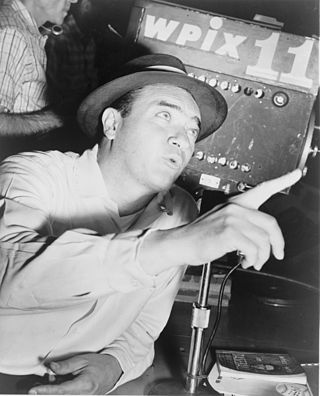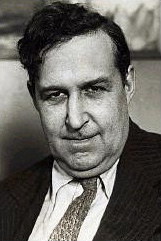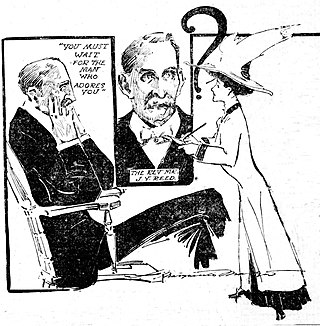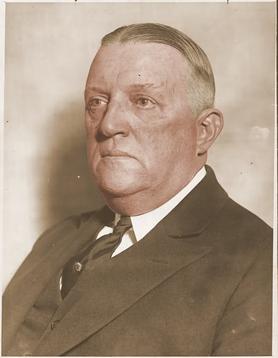Related Research Articles

The Yellow Kid is an American comic strip character that appeared from 1895 to 1898 in Joseph Pulitzer's New York World, and later William Randolph Hearst's New York Journal. Created and drawn by Richard F. Outcault in the comic strip Hogan's Alley, it was one of the first Sunday supplement comic strips in an American newspaper, although its graphical layout had already been thoroughly established in political and other, purely-for-entertainment cartoons. Outcault's use of word balloons in the Yellow Kid influenced the basic appearance and use of balloons in subsequent newspaper comic strips and comic books.
Yellow journalism and yellow press are American terms for journalism and associated newspapers that present little or no legitimate, well-researched news while instead using eye-catching headlines for increased sales. Techniques may include exaggerations of news events, scandal-mongering, or sensationalism. By extension, the term yellow journalism is used today as a pejorative to decry any journalism that treats news in an unprofessional or unethical fashion.

The muckrakers were reform-minded journalists, writers, and photographers in the Progressive Era in the United States (1890s–1920s) who claimed to expose corruption and wrongdoing in established institutions, often through sensationalist publications. The modern term generally references investigative journalism or watchdog journalism; investigative journalists in the US are occasionally called "muckrakers" informally.

Puck was the first successful humor magazine in the United States of colorful cartoons, caricatures and political satire of the issues of the day. It was founded in 1876 as a German-language publication by Joseph Keppler, an Austrian immigrant cartoonist. Puck's first English-language edition was published in 1877, covering issues like New York City's Tammany Hall, presidential politics, and social issues of the late 19th century to the early 20th century.

Mel Allen was an American sportscaster, best known for his long tenure as the primary play-by-play announcer for the New York Yankees. During the peak of his career in the 1940s, 1950s and 1960s, Allen was arguably the most prominent member of his profession, his voice familiar to millions. Years after his death, he is still promoted as having been "The Voice of the Yankees."

Sports journalism is a form of writing that reports on matters pertaining to sporting topics and competitions. Sports journalism started in the early 1800s when it was targeted to the social elite and transitioned into an integral part of the news business with newspapers having dedicated sports sections. The increased popularity of sports amongst the middle and lower class led to the more coverage of sports content in publications. The appetite for sports resulted in sports-only media such as Sports Illustrated and ESPN. There are many different forms of sports journalism, ranging from play-by-play and game recaps to analysis and investigative journalism on important developments in the sport. Technology and the internet age has massively changed the sports journalism space as it is struggling with the same problems that the broader category of print journalism is struggling with, mainly not being able to cover costs due to falling subscriptions. New forms of internet blogging and tweeting in the current millennium have pushed the boundaries of sports journalism.

The New York World was a newspaper published in New York City from 1860 until 1931. The paper played a major role in the history of American newspapers. It was a leading national voice of the Democratic Party. From 1883 to 1911 under publisher Joseph Pulitzer, it was a pioneer in yellow journalism, capturing readers' attention with sensation, sports, sex and scandal and pushing its daily circulation to the one-million mark. It was sold in 1931 and merged into the New York World-Telegram.

The New York Journal-American was a daily newspaper published in New York City from 1937 to 1966. The Journal-American was the product of a merger between two New York newspapers owned by William Randolph Hearst: The New York American, a morning paper, and the New York Evening Journal, an afternoon paper. Both were published by Hearst from 1895 to 1937. The American and Evening Journal merged in 1937.

Heywood Campbell Broun Jr. was an American journalist. He worked as a sportswriter, newspaper columnist, and editor in New York City. He founded the American Newspaper Guild, later known as The Newspaper Guild and now as The NewsGuild-CWA. Born in Brooklyn, New York, he is best remembered for his writing on social issues and his championing of the underdog. He believed that journalists could help right wrongs, especially social ills.

The history of American newspapers begins in the early 18th century with the publication of the first colonial newspapers. American newspapers began as modest affairs—a sideline for printers. They became a political force in the campaign for American independence. Following independence the first amendment to U.S. Constitution guaranteed freedom of the press. The Postal Service Act of 1792 provided substantial subsidies: Newspapers were delivered up to 100 miles for a penny and beyond for 1.5 cents, when first class postage ranged from six cents to a quarter.

Journalism in the United States began humbly and became a political force in the campaign for American independence. Following independence, the first amendment to the U.S. Constitution guaranteed freedom of the press and freedom of speech. The American press grew rapidly following the American Revolution. The press became a key support element to the country's political parties, but also for organized religious institutions.
Nicholas J. Cull is a historian and professor in the Master's in Public Diplomacy program at the Annenberg School for Communication and Journalism at the University of Southern California. He was the founding director of this program and ran it from 2005 to 2019.
Franz Douskey is an American writer. His work has been published in hundreds of magazines and anthologies, including The Nation, The New Yorker, Rolling Stone, Las Vegas Life, Yankee, USA/Today, The Georgia Review, The New York Times, Baseball Diamonds, and Yellow Silk. His first full-length book of poetry, Rowing Across the Dark, was published by the University of Georgia Press in 1982.

Frank Luther Mott was an American academic, historian and journalist, who won the 1939 Pulitzer Prize for History for Volumes II and III of his series, A History of American Magazines.

Martin E. Appel, is an American public relations and sports management executive, television executive producer, baseball historian and author.
Frank Irving Cobb was an American journalist, primarily an editorial writer from 1896 to his death. In 1904 he succeeded Joseph Pulitzer as editor of Pulitzer's newspaper The World of New York. He became famous for his editorials in support of the policies of liberal Democrats, especially Woodrow Wilson, during the Progressive Era.

Melissa Ludtke is an American journalist. In 1978, as a young sports journalist, Ludtke won a lawsuit for the right to be allowed in Major League Baseball locker rooms.

Joseph Spencer Vila was an American sportswriter and editor. He has been regarded as one of the most influential sportswriters during the first third of the 20th century, while setting fundamental changes in sports coverage during the decades to come.

William Joseph "Bill" Slocum was an American sports writer. He was born and raised in Winsted, Connecticut, the son of Michael and Sarah Slocum. His father had been a deputy sheriff, and his brother John also had a career in law enforcement, rising to the position of Winsted's police superintendent. After attending high school at St. Thomas Seminary in Hartford, Connecticut, Bill Slocum decided on a career in journalism, and gravitated toward sports. One of his first jobs was as the Winsted correspondent for the Waterbury American. He then became a sportswriter for the Waterbury Republican newspaper. By 1910, he had gotten hired in New York City, joining the sports staff of the New York Times. Slocum spent more than twenty-five years covering baseball for New York newspapers that included the Times, Tribune, Sun, and American.
References
- ↑ Reynolds, Francis Joseph (1924). Adair's New Encyclopedia...: A New and Up-to-date Reference Work for Home, School and Office...with Fifty Full Page Maps... World syndicate Company, Incorporated. p. 108. Retrieved 14 July 2022.
- ↑ Campbell, Joseph W. (2001). Yellow Journalism: Puncturing the Myths, Defining the Legacies. Westport, CT: Praeger. pp. 25–50. ISBN 0-275-98113-4.
- ↑ "Yankee Stadium". New York City Department of Parks & Recreation. Retrieved 2009-05-29.
- ↑ New York Public Library